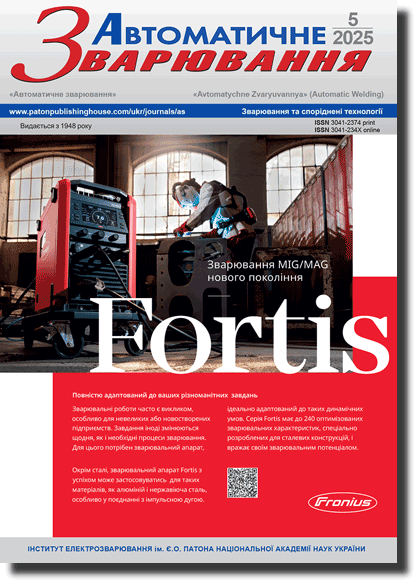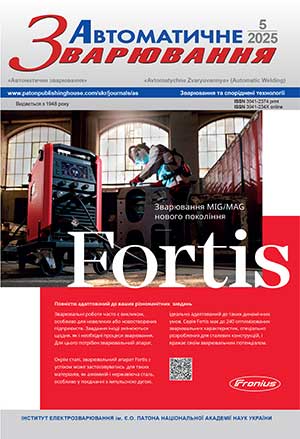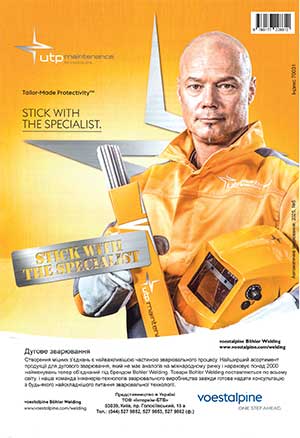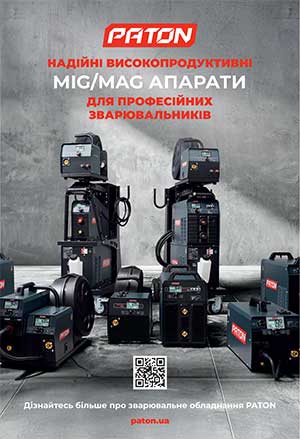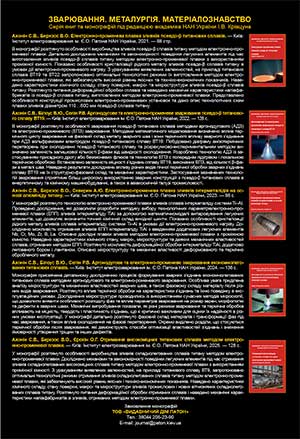| 2025 №05 (02) |
DOI of Article 10.37434/as2025.05.03 |
2025 №05 (04) |
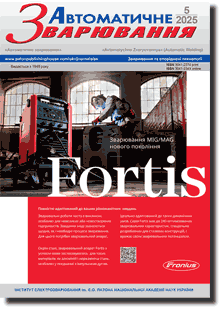
Журнал «Автоматичне зварювання», № 5, 2025, с. 25-30
Використання математичного методу перетворення гафа для металографічних досліджень мікроструктури ферито-бейнітних сталей
В.В. Головко1, О.О. Штофель1,2, Д.Ю. Короленко1
1ІЕЗ ім. Є.О. Патона НАН України. 03150, м. Київ, вул Казимира Малевича, 11. E-mail: v_golovko@ukr.net2Національний технічний університет України «Київський політехнічний інститут імені Ігоря Сікорського». 03056, м. Київ, Берестейський проспект, 37. E-mail: o.shtof@gmail.com
Високоміцні низьколеговані сталі є перспективним матеріалом для виготовлення зварних металоконструкцій, але їх поширення гальмується через підвищену схильність до утворення дефектів внаслідок зварювання. Тому фундаментальним аспектом розробки технології їх зварювання є розуміння того, як властивості металу змінюються під час процесу зварювання, та виявлення основних мікроструктурних характеристик, які пояснюють ці зміни. Дослідження високоміцних ферито-бейнітних сталей, які стосуються мікроструктурних характеристик і механічних властивостей, спрямовані на визначення загального кута розорієнтації структурних зерен та використовують метод дифракції зворотного розсіювання електронів (EBSD), який може бути реалізовано на електронних мікроскопах, і потребують встановлення спеціального програмного забезпечення. Метод металографічного аналізу із використанням перетворення Гафа, який може бути реалізований на оптичних мікроскопах і не потребує спеціального програмного забезпечення, доцільно розглянути як альтернативу методу EBSD. Бібліогр. 24, рис. 5.
Ключові слова: високоміцна низьколегована сталь, зварювання, мікроструктура, металографічний аналіз, межі зерен, розорієнтація структурних зерен, перетворення Гафа
Надійшла до редакції 21.02.2025
Отримано у переглянутому вигляді 16.07.2025
Прийнято 12.09.2025
Список літератури
1. Hall, E.O. (1951) The deformation and ageing of mild steel: III Discussion of results. Proc. Phys. Soc. B, 64(9), 747–753. DOI: http://doi.org/10.1088/0370-1301/64/9/3032. Petch, N.J. (1953) The cleavage strength of polycrystals. J. Iron Steel Inst., 174, 25–28.
3. Chapetti, M., Miyata, H., Tagawa, T. et al. (2004) Fatigue strength of ultra-fine grained steels. Mater. Sci. Eng. A, 381, 331–336. DOI: https://doi.org/10.1016/j.msea.2004.04.055
4. Hansen, N. (2004) Hall-Petch relation and boundary strengthening. Scr. Mater., 51, 801–806. DOI: https://doi.org/10.1016/j.scriptamat.2004.06.002
5. Yang, X.L., Xu, Y.B., Tan, X.D., Wu, D. (2014) Influences of crystallography and delamination on anisotropy of Charpy impact toughness in API X100 pipeline steel. Mater. Sci. Eng. A, 607, 53–62. DOI: https://doi.org/10.1016/j.msea.2014.03.121
6. Joo, M.S., Suh, D.-W., Bae, J.H., Bhadeshia, H.K.D.H. (2012) Toughness anisotropy in X70 and X80 pipeline steels. Mater. Sci. Eng. A, 556, 601–606. DOI: http://dx.doi.org/10.1179/1743284713Y.0000000371
7. Jabr, H.M.A., Speer, J.G., Matlock, D.K. et al. (2013) Anisotropy of mechanical properties of API X70 spiral welded pipe steels. Mater. Sci. Forum, 753, 538–541. DOI: http://dx.doi.org/10.4028/www.scientific.net/MSF.753.538
8. Sanchez, N., Petrov, R., Bae, J.H., Kim, K. (2010) Texture dependent mechanical anisotropy of X80 pipeline steel. Adv. Eng. Mater., 12, 973–980. DOI: http://dx.doi.org/10.1002/adem.201000065
9. Cheng, S., Zhang, X., Zhang, J. et al. (2016) Effect of start cooling temperature on microstructure and properties of X80 pipeline steel. Mater. Sci. Eng. A, 666, 156–164. DOI: https://doi.org/10.1016/j.msea.2016.04.066
10. Herbig, M., Raabe, D., Li, Y.J. et al. (2014) Atomic-scale quantification of grain boundary segregation in nanocrystalline material. Physical Review Letters, 112, 126103. DOI: https://doi.org/10.1103/PhysRevLett.112.126103
11. Duan, Q., Yan, J., Zhu, G.H., Cai, Q.W. (2013) Effects of grain size and misorientation on anisotropy of X80 pipeline steel. Hot Working Tech., 24, 107–109. https://caod.oriprobe.com/articles/41006381/Effects_of_Grain_Size_and_Misorientation_on_Anisot.htm
12. Masoumi, M., Silva, C.C., Abreu, H.F.G.D. (2018) Effect of rolling in the recrystallization temperature region associated with a post-heat treatment on the microstructure, crystal orientation, and mechanical properties of API 5L X70 pipeline steel. J. Mater. Eng. Perfor., 27, 1694–1705. DOI: http://dx.doi.org/10.1590/1980-5373-mr-2016-0651
13. Deng, C.M., Li, Z.D., Sun, X.J., Yong, Q.L. (2014) Infl uence mechanism of high angle boundary on propagation of cleavage cracks in low martensite steel. Mater. Mech. Eng., 38, 20–24.
14. Shen, J.C., Luo, Z.J., Yang, C.F., Zhang, Y.Q. (2014) «Eff ective grain size» aff ecting low temperature toughness in lath structure of HSLA steel. J. Iron Steel Res. Int., 26(7), 70–76.
15. Hussein, A., Kim, B., Verbeken, K., Depover, T. (2024) The eff ect of grain boundary misorientation on hydrogen fl ux using a phase-fi eld based diff usion and trapping model. Advanced Engineering Materials, 26(22), 2401561. DOI: https://doi.org/10.1002/adem.202401561
16. Raabe, D., Herbig, M., Sandlöbes, S. et al. (2014) Grain boundary segregation engineering in metallic alloys: A pathway to the design of interfaces. Current Opinion in Solid State and Materials Science, 18, 253–261. DOI: https://doi.org/10.1016/j.cossms.2014.06.002
17. Stojanovic, N., Glisovic, J., Abdullah, O.I. et al. (2022) Particle formation due to brake wear, infl uence on the people health and measures for their reduction: a review. Environ Sci. Pollut Res., 29, 9606–9625. DOI: https://doi.org/10.1007/s11356-021-17907-3
18. Vincentis, N.S., Roatta, A., Bolmaro, R.E., Signorelli, J.W. (2019) EBSD analysis of orientation gradients developed near grain boundaries. Materials Research, 22(1), e20180412. DOI: https://doi.org/10.1590/1980-5373-MR-2018-0412
19. Pauli, L., Heikki, R. (2022) EBSD characterisation of grain size distribution and grain sub-structures for ferritic steel weld metals. Welding in the World, 66, 363–377. DOI: https://doi.org/10.1007/s40194-021-01225-w
20. Hwang, B., Kim, Y.G., Lee, S. et al. (2005) Eff ective grain size and charpy impact properties of high-toughness X70 pipeline steels. Metallurgical and Materials Transactions A, 36, 2107– 2114. DOI: https://doi.org/10.1007/s11661-005-0331-9
21. Stojanovic, N., Belhocine, A., Abdullah, O.I., Grujic, I. (2023) The infl uence of the brake pad construction on noise formation, people’s health and reduction measures. Environ Sci. Pollut Res., 30, 15352–15363. DOI: https://doi.org/10.1007/s11356-022-23291-3
22. Li, X.C., Zhao, J.X., Cong, J.H. et al. (2021) Machine learning guided automatic recognition of crystal boundaries in bainitic/martensitic alloy and relationship between boundary types and ductile-to-brittle transition behavior. J. Mater. Sci. Technol., 84, 49–58. DOI: https://doi.org/10.1016/j. jmst.2020.12.024
23. Atiquzzaman, M. (1992) Multiresolution hough transform-an effi cient method of detecting patterns in images. IEEE Trans. on Pattern Analysis and Machine Intelligence, 14(11), 1090– 1095. DOI: https://doi.org/10.1109/34.166623
24. Журавель І.М., Максимович В.М. (2018) Кількісний аналіз орієнтації та видовженості зерен на металографічних зображеннях за допомогою перетворень Хафа. Науковий вісник НЛТУ України, 28(5), 135–139. DOI: https://doi.org/10.15421/40280528
Реклама в цьому номері:
Щоб замовити електронну версію статті:
В.В. Головко, О.О. Штофель, �.Ю. КороленкоВикористання математичного методу перетворення гафа для металографічних досліджень мікроструктури ферито-бейнітних сталей
Автоматичне зварювання №05 2025 p.25-30
Вартість статті (pdf): 13 $, 12 €, 150 UAH (1 прим.)
заповніть форму:
Вартість передплати/замовлення на журнали або окремі статті
| журнал/валюта | річний комплект друкований |
1 прим. друкований |
1 прим. електронний |
одна стаття (pdf) |
| AS/UAH | 1800 грн. | 300 грн. | 300 грн. | 150 грн. |
| AS/USD | 192 $ | 32 $ | 26 $ | 13 $ |
| AS/EUR | 180 € | 30 € | 25 € | 12 € |
| TPWJ/UAH | 7200 грн. | 600 грн. | 600 грн. | 280 грн. |
| TPWJ/USD | 384 $ | 32 $ | 26 $ | 13 $ |
| TPWJ/EUR | 348 € | 29 € | 24 € | 12 € |
| SEM/UAH | 1200 грн. | 300 грн. | 300 грн. | 150 грн. |
| SEM/USD | 128 $ | 32 $ | 26 $ | 13 $ |
| SEM/EUR | 120 € | 30 € | 25 € | 12 € |
| TDNK/UAH | 1200 грн. | 300 грн. | 300 грн. | 150 грн. |
| TDNK/USD | 128 $ | 32 $ | 26 $ | 13 $ |
| TDNK/EUR | 120 € | 30 € | 25 € | 12 € |
AS = «Автоматичне зварювання» - 6 накладів на рік;
TPWJ = «PATON WELDING JOURNAL» - 12 накладів на рік;
SEM = «Сучасна електрометалургія» - 4 наклада на рік;
TDNK = «Технічна діагностика та неруйнівний контроль» - 4 наклада на рік.





